Chupacabras DNA Results Are In
Posted by: Loren Coleman on November 3rd, 2007
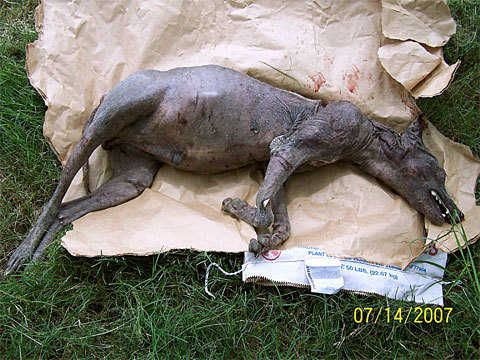
Contributed Photo: Phylis Canion
Well, no need to dwell on this one. We all saw this coming, and it appears only a few people and the media thought this was going to be anything different.
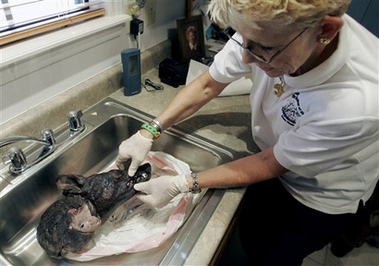
The DNA results are back from tests run on the “Chupacabras” (as it was called) found by Phylis Canion, near Cuero, Texas, in July, 2007. The biologists at the Texas State University have announced that it is a coyote (Canis latrans).
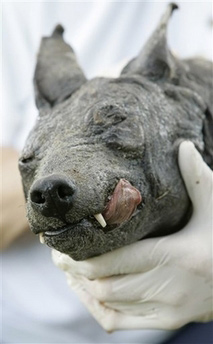
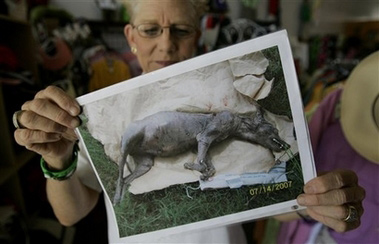
The DNA sequence is a virtually identical match to DNA from the coyote. This is probably the answer a lot of folks thought might be the outcome. I, myself, really thought it was a domestic dog, but the Cuero chupacabra[s] is a Texas coyote.
That is the best part about science. The first answers often lead to more questions and then better explanations of the world in which we live. We’ve taken additional skin samples and we will try to determine the cause of the hair loss.
Folks fear what they don’t understand, and a big part of the goal in science is to explain the natural world. – Mike Forstner, a Texas State University biologist, said in a news release, as quoted in “Strange beast found near Cuero is a coyote,” by Roger Croteau, Express-News, November 2, 2007.
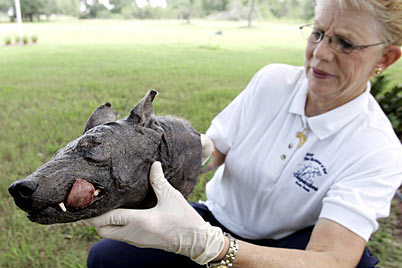
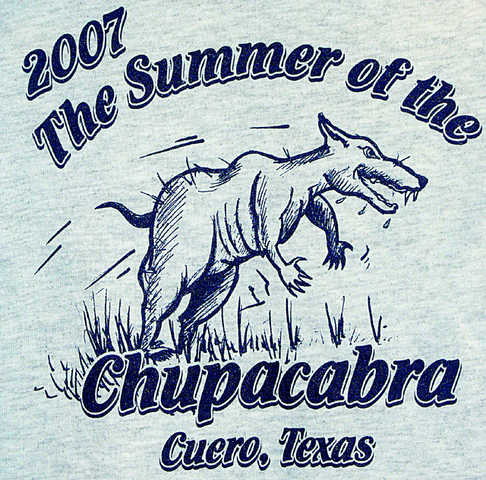
“Chupacabras: It’s sort of like Jennifer Lopez, kind of cross-cultural.” – Loren Coleman, as quoted by ABC News, 1999.
Why do I call all of them, singular and plural, “Chupacabras”? If interested in the answer, you will not be disappointed if you click on “Chupawhat?”
About Loren Coleman
Loren Coleman is one of the world’s leading cryptozoologists, some say “the” leading living cryptozoologist. Certainly, he is acknowledged as the current living American researcher and writer who has most popularized cryptozoology in the late 20th and early 21st centuries.
Starting his fieldwork and investigations in 1960, after traveling and trekking extensively in pursuit of cryptozoological mysteries, Coleman began writing to share his experiences in 1969. An honorary member of Ivan T. Sanderson’s Society for the Investigation of the Unexplained in the 1970s, Coleman has been bestowed with similar honorary memberships of the North Idaho College Cryptozoology Club in 1983, and in subsequent years, that of the British Columbia Scientific Cryptozoology Club, CryptoSafari International, and other international organizations. He was also a Life Member and Benefactor of the International Society of Cryptozoology (now-defunct).
Loren Coleman’s daily blog, as a member of the Cryptomundo Team, served as an ongoing avenue of communication for the ever-growing body of cryptozoo news from 2005 through 2013. He returned as an infrequent contributor beginning Halloween week of 2015.
Coleman is the founder in 2003, and current director of the International Cryptozoology Museum in Portland, Maine.










Every time someone finds a carcass of a strange looking animal like the Chupacabra. Its always a K9 of some sort. Like wild dogs in Chile and Puerto Rico, Coyotes in Texas and much more. So is it wild dogs killing farms animals?
I’m glad that the results are in, because I’m sure there were still those out there insisting that this was a mystery creature of some kind. Everyone take note on how freakish diseased or mangy animals can look and keep that in mind when confronted with photos that at first seem mystifying. Sometimes people want a fantastic explanation when a mundane one fits just fine. It’s interesting that when seeing an animal like this, some will immediately call it a chupacabras and others will say “yeah, maybe it is!”. Why doesn’t anyone ever say “look, its a mangy coyote!” And why is it if they do, people say “how do you know it is a mangy coyote? It might be chupacabras! You have to have an open mind!” ? Not to say that mystery animals are not out there, just that we have to be rational and scientific about finding them. I think we need to maintain a critical eye when appraising the visual evidence. In my opinion it does not help the honest search for cryptids to jump to conclusions on these types of cases. Anyway I’m glad that they had a body on which to perform the necessary tests.
that is one ugly-lookin coyote….. XD
Is it non Latinos making those identifications? The various Latino descriptions sound more like predatory kangaroo-like marsupials or even velociraptor relatives.
Duh.
I knew it.
I can’t believe that nobody has gotten any footage of a Chupacabras yet. We got footage of Sasquatch, what’s up with that?
That shirt would be cool to have. I’m just wondering if and when you guys at Cryptomundo are gonna come at with some cool cryptid shirts. That would rock to have a Cryptomundo shirt. I’d be wearing it everywhere.
Duh! Duh, and thrice duh!
Come on, people, it’s a pooch. Why go to the expense of DNA testing?
This should be called the “Summer of Mange”,…seems to be alot of it out there!!!
Imagine that! A Coyotecabras.
What I want to know is, how come every time someone finds a mangy canine carass, it’s called a Chupacabra? Every description I’ve ever heard of a Chupacabras is of some weird alien/reptilian/humaniod thing with big bug eyes and quills or spines on its back, not of a doglike animal.
Wow! A Coyote this time? Usually in Texas they are just decaying Samson Foxes
Lately, I’ve been pondering on what large creature could survive only drinking the fluids of animals, besides a giant vampire bat. Getting to the point, the only creatures that would need to drain it’s victims of fluids are arachnids, so it is my theory that the Chupacabras are really giant spiders. It isn’t so far fetched, giant spiders did exist in pre-history, and it is possible they may have survived in modern times.
All I have to say about Chupacabras, is what happen to the sightings that were going on in Costa Rica? Originally, that was where I first heard about Chup, and from there it was definitely some sort of bipedal thing that was being seen.
Since then, Chupacabras caught on over here, and everytime some small animal is killed, Chup gets blamed for it…from a folklore standpoint, it is very interesting..the way it has spread and the way people have latched on to the name and the idea. However, the original Chupacabras that I became familiar with appeared to be something very different than wild coyotes…and again, I don’t know that the bipedal variety was ever seen in America (correct me if I am wrong).
And to Curious86…that is a sound idea…never thought about really big spiders…but they do exist (Bird Eating, Goliath, etc.), and maybe there is something out there as yet unknown that is creeping its way toward civilization because of deforestation and invading its homeground…that idea would not make my sister-in-law happy at all:)